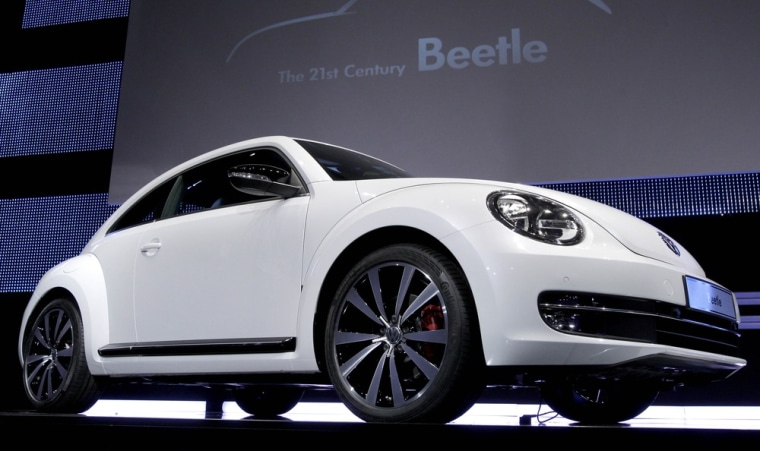It’s one of the best known (and best-selling) automotive brand names in history. But how much life is left in the old Volkswagen Beetle?
That’s the new Beetle, the vehicle that’s getting a global roll-out this week at both the New York and Shanghai auto shows.
The 2012 version of the Beetle is only the second complete remake of the original “people’s car” since it was first launched 73 years ago. In an industry where new is almost always better for most buyers, the original Beetle was a surprisingly successful anachronism for six decades. But the “New Beetle,” launched in 1998, had nowhere near the staying power.
After much internal debate over whether to even keep the Beetle alive, Volkswagen decided that it was not just another model in a steadily expanding line-up, but rather it was “a part of the heartbeat of the organization,” explained Jonathan Browning, CEO of Volkswagen Group of America.
The 1998 Beetle remake was a much-needed success for Volkswagen — at least initially. If anything, it strained the company’s resources, both on the manufacturing and marketing side. But the success was relatively short-lived. And the car soon saw demand plunge, especially outside the U.S. market. In Germany it was barely visible on the sales charts.
It was also a polarizing product, especially when considered by gender, appealing to a broad group of women, but leaving most men cold.
So when the decision was made to re-do the people’s car, Volkswagen brand design director Klaus Bischoff knew he had some serious challenges to overcome.
“I didn’t want to lose this beloved icon for the brand,” said Bischoff, in an interview following the introduction of the newest Beetle Monday. “It was clear for us designers that we didn’t want to follow the path of the [1998] New Beetle. That game was over.”
Though there were clear similarities between the 1998 remake and the 1938 original, the so-called New Beetle adopted a design that was little more than a series of overlapping semi-circles. The new model returns to the basic dimensions of the first Beetle, with a pronounced snout and a more upright windshield, as well as the large, round headlamps.
There are a variety of details — such as the bigger wheels and the built-in rear wing — that give the 2012 Beetle a more macho, sporty feel that Bischoff’s team felt would expand the car’s appeal to men — and so will the layout of the interior, he contends.
The 1998 Beetle design created a sort of microvan space, with plenty of room in front of the driver. The 2012 Beetle has more of a cockpit-like feel, closer to the original Beetle — as well as the classic Porsche 911, which traces its roots to the same source, the German car legend Ferdinand Porsche.
But the new Beetle is anything but claustrophobic. It is wider and a full six inches longer than the 1998 design, yielding significantly more passenger and cargo space.
Volkswagen not only hopes to increase the next Beetle’s appeal to men, but also to expand its reach beyond U.S. shores. Nonetheless, succeeding here in the U.S. would be a very important start, the company’s design chief said, noting that “the American customer influences all customers worldwide. Setting a trend here will set a trend everywhere.”
Scoring a hit would be great news for the increasingly aggressive Volkswagen, which plans to roughly double its current U.S. sales to 800,000 a year by 2016. That would finally permit it to break through the seemingly impenetrable peak set by the original Beetle four decades ago.
The German automaker also has set an unabashed goal of dethroning current global automotive king-of-the-hill Toyota by 2016. And, said Browning, the Beetle would be crucial in achieving that target, as well, by reviving the VW brand’s identifying icon.
The executive wouldn’t discuss a sales target for the third-generation Beetle, though he hinted it will be “somewhere between” the brand’s best-selling Jetta line, which generates about 100,000 sales annually, and the EOS convertible, a niche model pulling in volumes of under 20,000 per year.
“It’s an iconic model that was long overdue for a change,” said Dave Sullivan, automotive analyst with the consulting firm, AutoPacific, Inc. “There’s a definite market” for the Beetle, but it will have to overcome the objections that wore down demand for the old model, he cautioned.
Just don’t expect to see it generate anywhere near the sales of the original. During more than six decades on the market, the Beetle became one of the most popular automotive products in history, ultimately selling over 20 million vehicles in car markets from Berlin to Mexico City.
However, the 1998-generation Beetle hasn’t even managed a tenth of that volume, with sales of the vehicle so far totaling 477,000.
While the 2012 model might have a retro-tinged design, VW hopes to follow a very modern marketing strategy, which will include the steady roll-out of Beetle variants, including a turbo and, later, a convertible.
While the third-generation coupe likely won’t be around for six decades, VW does hope it can maintain its drawing power for quite some time.
